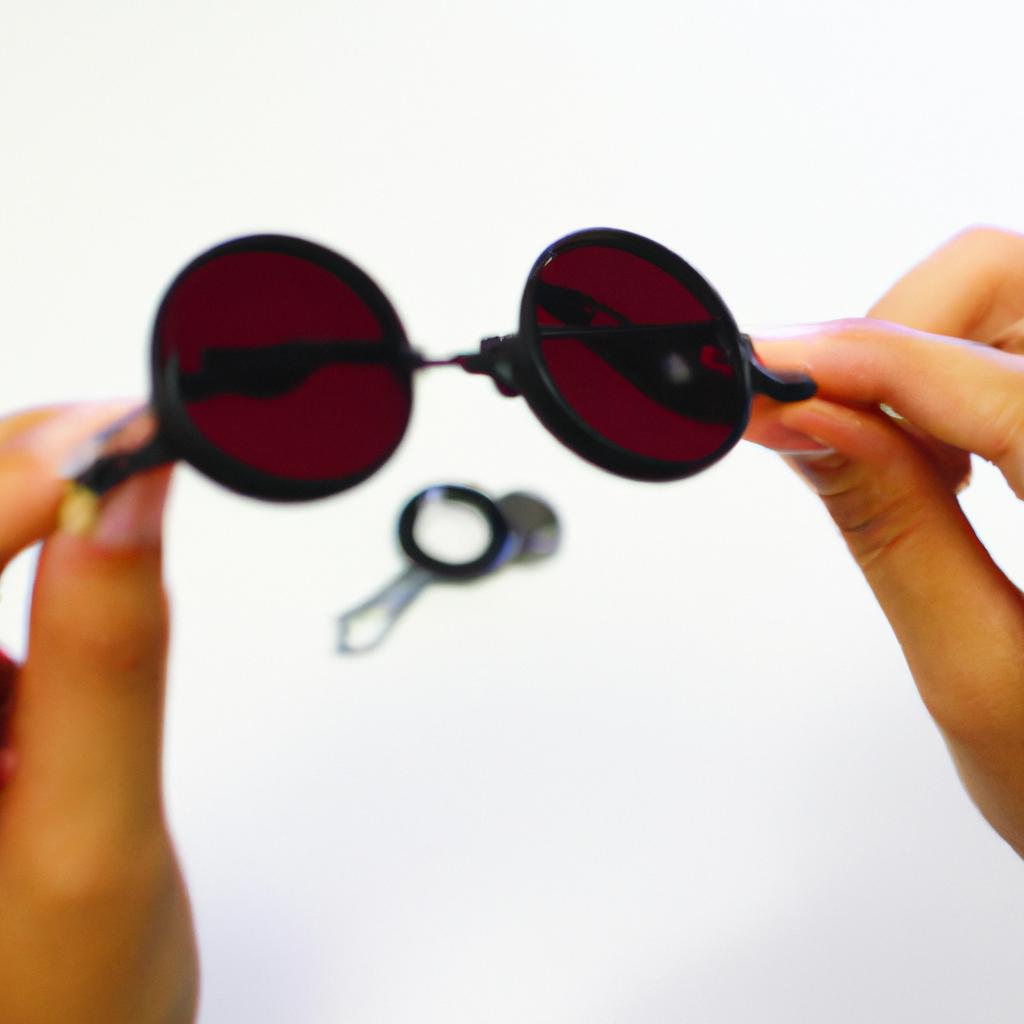Payday Loan Consolidation: Sunglasses Essential Guide

Payday loans have become a common financial solution for individuals facing unexpected expenses or short-term cash shortages. However, the convenience of these loans often comes with exorbitant interest rates and fees, trapping borrowers in a cycle of debt. As a result, many people find themselves overwhelmed by multiple payday loan repayments each month, struggling to make ends meet. In such circumstances, payday loan consolidation can provide relief and help individuals regain control over their finances.
For instance, let’s consider the hypothetical case of Sarah. She had taken out several payday loans to cover medical bills and car repairs but soon found herself unable to keep up with the high-interest payments. Faced with mounting debts and constant harassment from lenders, she felt trapped and desperate for a way out. This is where payday loan consolidation steps in as an essential guide towards financial stability.
In this article, we will explore the concept of payday loan consolidation in depth, discussing its benefits and potential drawbacks. We will examine how it works, what options are available for consolidating payday loans, and how individuals like Sarah can navigate through the process successfully. By understanding the intricacies of payday loan consolidation and arming oneself with valuable information, readers will be better equipped to make informed decisions regarding their own financial situations.
Understanding the Basics of Optical Lenses
Imagine this scenario: Sarah, a 30-year-old office worker, has been experiencing frequent headaches and eye strain over the past few months. After visiting an optometrist, she learns that her symptoms are likely caused by her outdated prescription glasses. The optometrist recommends getting new lenses that are tailored to her specific needs. This example demonstrates the importance of understanding optical lenses and their impact on our visual health.
To grasp the basics of optical lenses, it is essential to delve into three key aspects: lens power, lens design, and lens coatings. Firstly, lens power refers to the strength required for correction in order to achieve optimal vision. Determined through a comprehensive eye examination, this measurement helps individuals attain clear vision at different distances. Secondly, lens design plays a crucial role in ensuring comfortable use throughout the day. Various designs such as single vision lenses (for nearsightedness or farsightedness) and progressive lenses (for presbyopia) cater to different visual needs. Lastly, lens coatings provide additional benefits such as reducing glare and protecting against harmful UV rays.
The significance of understanding these basic concepts becomes evident when considering the emotional aspect of wearing eyeglasses. Let us take a closer look:
- Improved Clarity: Clear vision allows individuals like Sarah to perform daily tasks with ease and confidence.
- Enhanced Comfort: Properly designed lenses ensure comfort during prolonged periods of wear.
- Reduced Eye Strain: Coatings like anti-glare can minimize discomfort caused by excessive light exposure.
- Long-lasting Durability: Investing in quality materials contributes to longer lifespan and cost-effectiveness.
Embracing these advantages fosters not only better visual health but also improved overall well-being.
In moving forward towards exploring “Different Types of Lens Materials,” it is important to build upon this foundation about optical lenses while delving deeper into various material options available for eyeglass manufacturing
Different Types of Lens Materials
Transitioning smoothly from the previous section on optical lenses, let’s now delve into the various types of lens materials commonly used in sunglasses. By understanding these different materials and their unique properties, you can make an informed decision when choosing your ideal pair of shades.
Imagine a scenario where Sarah, an avid hiker, is searching for sunglasses that offer both durability and protection against harmful UV rays. She comes across several options made from different lens materials such as glass, polycarbonate, acrylic, and CR-39 plastic. Each material has its own strengths and weaknesses, making it crucial to consider factors like impact resistance and clarity before making a selection.
To help you navigate this decision-making process effectively, here are some key points about each type of lens material:
-
Glass:
- Excellent scratch resistance.
- Crystal-clear optics provide exceptional visual quality.
- Heavier compared to other materials.
- More prone to shattering upon impact.
-
Polycarbonate:
- Highly impact-resistant.
- Lightweight, suitable for sports activities.
- May have slight distortion in peripheral vision.
- Requires proper care to prevent scratches.
-
Acrylic:
- Affordable option with good optical clarity.
- Less durable than glass or polycarbonate.
- Susceptible to scratching easily if not handled carefully.
- Recommended for occasional use rather than active lifestyles.
-
CR-39 Plastic:
- Offers superior optical performance at an affordable price.
- Moderate impact resistance but less durable than polycarbonate.
- Can be more susceptible to scratches over time.
Understanding the pros and cons associated with each lens material allows consumers like Sarah to select sunglasses that align with their specific needs and preferences. Whether it’s prioritizing durability, visual clarity, or affordability, being aware of these factors empowers individuals to make informed purchasing decisions.
With a solid grasp of the different lens materials available for sunglasses, we can now move forward and explore the benefits of lens coatings. By enhancing the performance and functionality of lenses, coatings offer additional features that augment your overall experience with sunglasses.
As we move ahead into exploring the Benefits of Lens Coatings section, let’s further uncover how they can elevate your sunglass-wearing experience without compromising on style or protection.
Exploring the Benefits of Lens Coatings
Transition: Understanding the Benefits of Lens Coatings
As we delve further into the world of sunglasses, it is essential to explore the benefits that lens coatings can provide. These specialized coatings offer various advantages, from enhancing visual clarity to protecting your eyes against harmful UV rays and reducing glare. By understanding these benefits, you can make an informed decision when choosing the right pair of sunglasses for your needs.
One example of a lens coating with remarkable benefits is an anti-reflective (AR) coating. This thin layer applied to the surface of lenses helps reduce reflections and glare caused by artificial lighting or sunlight bouncing off surfaces like water or snow. Imagine being able to enjoy a day at the beach without straining your eyes due to excessive brightness reflecting off the sand!
To further emphasize the advantages offered by lens coatings, let’s take a look at some bullet points:
- Enhanced Visual Clarity: Lens coatings improve overall visual acuity by minimizing distortions and increasing contrast.
- UV Protection: Coatings such as UV filters shield your eyes from harmful ultraviolet radiation, preventing long-term damage.
- Reduced Eye Fatigue: With reduced glare and reflections, coated lenses lessen eye strain during prolonged use in bright environments.
- Improved Aesthetics: Certain coatings can give lenses a sleek appearance while also making them easier to clean and maintain.
Now, let’s examine this information in a concise table format:
| Benefit | Description |
|---|---|
| Enhanced Visual Clarity | Improved acuity, reduced distortions, and increased contrast |
| UV Protection | Shields your eyes from damaging UVA and UVB radiation |
| Reduced Eye Fatigue | Minimizes glare and reflections for decreased strain during extended wear |
| Improved Aesthetics | Sleek appearance with added ease in cleaning and maintenance |
In conclusion, lens coatings play a vital role in enhancing your sunglasses’ performance and protecting your eyes. By reducing glare, improving visual clarity, and providing UV protection, coated lenses offer a comprehensive solution to address various eye-related concerns. With this understanding, you can now move on to the next section: Choosing the Right Optical Lens for Your Needs.
Transition: Now that we have explored the benefits of lens coatings, let’s delve into the process of choosing the right optical lens for your needs.
Choosing the Right Optical Lens for Your Needs
Transitioning from the previous section discussing lens coatings, we now delve into selecting the appropriate optical lenses to meet your specific needs. To illustrate this, let us consider a hypothetical scenario where Emily, an avid hiker, is looking for sunglasses that offer both UV protection and durability.
When choosing sunglasses, it is crucial to take certain factors into account. Firstly, the level of ultraviolet (UV) radiation protection provided by the lenses should be a priority. In Emily’s case, she requires sunglasses with 100% UVA and UVB protection due to her outdoor activities. Ensuring adequate UV blocking will safeguard her eyes against harmful rays and minimize the risk of long-term damage such as cataracts or macular degeneration.
Secondly, considering the lifestyle and intended use of sunglasses is essential. For active individuals like Emily who engage in strenuous physical activities like hiking or running, lightweight and impact-resistant lens materials are preferable. Polycarbonate lenses are a popular choice due to their resistance to shattering upon impact.
To further guide consumers in making informed decisions when selecting sunglasses suitable for different circumstances, below is a list highlighting key considerations:
- Lens color options (e.g., gray, brown): Different tints can enhance visibility under specific conditions.
- Polarized lenses: Reduce glare caused by reflections off surfaces like water or snow.
- Photochromic lenses: Automatically adjust tint levels based on ambient lighting conditions.
- Mirrored coatings: Reflect excessive light away from the eyes while providing privacy.
Moreover, presenting information visually through tables allows for easy comparison among various attributes. Below is a table comparing different types of sunglass lens materials:
| Lens Material | Pros | Cons |
|---|---|---|
| Glass | Excellent optical clarity | Heavier and more fragile |
| Polycarbonate | Lightweight and shatter-resistant | Prone to scratches |
| Trivex | Similar qualities as polycarbonate | Limited availability |
| High-index | Thinner lenses for higher prescriptions | More expensive |
In summary, when choosing sunglasses, it is essential to prioritize UV protection while considering the intended use of the glasses. By assessing factors such as lens color options, polarized or photochromic capabilities, and additional coatings like mirrors, individuals can make informed choices that align with their needs.
Transitioning smoothly into the subsequent section about “Factors to Consider When Selecting Lens Materials,” we will now discuss important aspects to be mindful of during this selection process.
Factors to Consider When Selecting Lens Materials
Having explored the process of choosing the right optical lens for your needs, let us now delve into another crucial aspect – understanding the importance of lens coatings. To illustrate this point, consider a scenario where two individuals purchase sunglasses with identical lenses but different coating options. Individual A opts for sunglasses without any coatings, while individual B chooses a pair with advanced anti-reflective and UV protection coatings. As they wear their respective sunglasses on a bright sunny day, it becomes evident that individual B experiences enhanced visual clarity and reduced glare compared to individual A.
Lens coatings play a significant role in improving the performance and durability of eyewear. Here are some key reasons why investing in coated lenses is essential:
-
Enhancing Visual Comfort: Coatings like anti-reflective (AR) help eliminate reflections caused by artificial light sources or sunlight bouncing off the back surface of the lens. This reduces eye strain and improves overall visual comfort, especially when working on digital screens or driving at night.
-
Protecting Against Harmful UV Rays: UV protection coatings shield your eyes from harmful ultraviolet (UV) rays emitted by the sun, which can lead to long-term damage such as cataracts and macular degeneration. Opting for sunglasses with proper UV protection is vital to safeguard your eye health.
-
Increasing Durability and Scratch Resistance: Some lens coatings, such as scratch-resistant coatings, create an additional layer that makes lenses more resistant to everyday wear and tear. This helps prolong the lifespan of your eyewear investment by reducing scratches and preserving optimal vision quality.
-
Improving Aesthetic Appeal: Certain specialized lens coatings provide added cosmetic benefits such as reducing smudges or repelling water droplets. These features not only enhance visual aesthetics but also contribute to easier maintenance and cleaning of your eyewear.
| Coating Type | Benefits |
|---|---|
| Anti-Reflective (AR) | Reduces glare and improves visual clarity |
| UV Protection | Shields against harmful UV rays |
| Scratch Resistance | Enhances durability and minimizes scratches |
| Hydrophobic | Repels water droplets for better visibility |
In summary, lens coatings are an integral aspect of eyewear that significantly impact visual comfort, eye health protection, durability, and aesthetic appeal. By investing in coated lenses, you can enhance your overall optical experience and ensure long-lasting satisfaction with your sunglasses or prescription glasses.
Now that we have explored the importance of lens coatings, let us delve into understanding different types of lens materials.
Understanding the Importance of Lens Coatings
Transition from Previous Section
Having considered the various factors related to Lens Materials, it is now important to delve into another crucial aspect of sunglasses – understanding the importance of lens coatings. By exploring different coating options, you can enhance the performance and durability of your lenses, ensuring optimal vision protection.
Understanding the Importance of Lens Coatings
To illustrate the significance of lens coatings, let’s consider a hypothetical scenario: Sarah has recently invested in a pair of high-quality sunglasses with polarized lenses. However, despite their superior lens material, she notices that her vision is often compromised due to glare while driving or spending time outdoors. This situation highlights the need for effective lens coatings that can further improve visual clarity and reduce eye strain.
Lens coatings offer multiple benefits beyond what bare lenses provide. Here are some key advantages:
- Anti-reflective (AR) coating: This coating reduces reflections on both sides of the lens, enhancing visual acuity by allowing more light transmission through the lenses.
- Scratch-resistant coating: As its name suggests, this protective layer minimizes scratches caused by everyday wear and tear.
- Hydrophobic coating: Ideal for climates prone to rain or humidity, this water-repellent solution prevents droplets from accumulating on the surface of the lenses.
- UV-blocking coating: A vital component for any sunglass wearer, this specialized coating filters out harmful ultraviolet rays, protecting your eyes from potential damage.
These four essential lens coatings work together harmoniously to optimize both functionality and longevity. Their combined effect ensures clear vision, reduced eyestrain, improved durability against scratches, resistance to moisture buildup, and reliable UV protection.
| Benefits | Anti-Reflective Coating | Scratch-Resistant Coating | Hydrophobic Coating |
|---|---|---|---|
| Improved Visual Acuity | ✓ | ||
| Enhanced Durability | ✓ | ||
| Resistance to Moisture | ✓ | ||
| Protection from UV Rays |
In conclusion, Lens Coatings play a vital role in maximizing the performance and longevity of your sunglasses. By investing in appropriate coatings such as anti-reflective, scratch-resistant, hydrophobic, and UV-blocking options, you can significantly enhance visual clarity while safeguarding your eyes against potential harm.
Transition
Now that we have explored the importance of lens coatings, let’s move on to comparing the durability of different lens materials.
Comparing the Durability of Different Lens Materials
Lens coatings play a crucial role in enhancing the durability and performance of optical lenses. As we have explored in the previous section, lens coatings provide various benefits such as reducing glare, protecting against scratches, and improving visual clarity. Now, let’s delve further into the significance of lens coatings by examining their impact on vision quality and overall lens lifespan.
To illustrate this point, consider a hypothetical scenario where two individuals purchase identical sunglasses with different types of lens coatings. The first individual opts for sunglasses without any coating, while the second chooses sunglasses with an anti-reflective (AR) coating. Both individuals wear their sunglasses regularly during outdoor activities.
Over time, the individual wearing sunglasses without any coating starts to experience discomfort due to increased glare from sunlight reflecting off surfaces such as water or snow. This makes it difficult to see clearly and causes eye strain. On the other hand, the individual wearing AR-coated sunglasses notices a significant reduction in glare, resulting in enhanced visual comfort and improved clarity of vision.
This example highlights how lens coatings can make a tangible difference in one’s everyday life. To further emphasize their importance, here are some key advantages provided by well-applied lens coatings:
- Reduced Eye Strain: By minimizing reflections and glare, lens coatings reduce eye fatigue that can result from extended exposure to bright light sources.
- Enhanced Visual Acuity: Coatings like anti-scratch or hydrophobic layers improve overall optics by increasing contrast sensitivity and reducing distortions caused by smudges or scratches.
- Protection Against Harmful UV Rays: Certain lens coatings offer additional protection against harmful ultraviolet (UV) rays emitted by the sun, safeguarding your eyes from potential long-term damage.
- Extended Lifespan: Applying protective coatings prolongs the longevity of your lenses by shielding them against daily wear-and-tear factors like dust particles or accidental drops.
To summarize, investing in quality lens coatings is essential to ensure optimal visual performance, comfort, and longevity of your optical lenses.
Now that we have understood the significance of lens coatings, let’s move on to exploring the various options available to enhance your optical lenses. By selecting appropriate coatings based on your specific needs and preferences, you can further optimize your visual experience and protect your investment in eyewear.
Exploring the Different Coating Options for Optical Lenses
Payday Loan Consolidation: Sunglasses Essential Guide
Now, let’s delve into an essential aspect when it comes to optical lenses – exploring the different coating options available.
When choosing sunglasses, it is crucial to consider not only the material but also the coatings applied to enhance their properties. Let us take a hypothetical example: Sarah, who frequently engages in outdoor activities such as hiking and skiing, requires sunglasses that offer both UV protection and scratch resistance. By comparing various lens coatings available on the market, she can make an informed decision based on her specific needs.
To help you understand these coatings better, here are some key points:
- Anti-reflective (AR) coating reduces glare by minimizing light reflection from the front and back surfaces of your lenses.
- Scratch-resistant coating provides added durability by making lenses more resistant to scratches from daily wear and tear.
- Hydrophobic coating repels water droplets, reducing smudging and allowing for easier cleaning.
- Mirror coating reflects light away from your eyes, providing additional protection against intense sunlight.
Let’s dive deeper into these coatings with a three-column table showcasing their benefits:
| Coating | Benefits |
|---|---|
| Anti-reflective (AR) | – Reduces glare |
| – Improves visual comfort | |
| Scratch-resistant | – Increases lens durability |
| – Protects against everyday wear | |
| Hydrophobic | – Repels water droplets |
| – Makes lenses easier to clean | |
| Mirror | – Reflects light away |
| – Offers extra sun protection |
By understanding how each coating enhances sunglass performance, individuals like Sarah can select lenses tailored to their specific requirements. This knowledge empowers consumers to make informed decisions, ensuring they receive the best optical experience possible.
Transitioning into our subsequent section about “Tips for Proper Maintenance of Optical Lenses,” it is essential to care for your sunglasses properly. By following these guidelines, you can ensure their longevity and optimal performance in various conditions.
Tips for Proper Maintenance of Optical Lenses
Exploring the Benefits of Polarized Sunglasses
When it comes to protecting our eyes from harmful UV rays and reducing glare, polarized sunglasses are a popular choice among many individuals. Let’s delve into the benefits these specialized lenses offer.
One example of the effectiveness of polarized sunglasses is in driving situations. Imagine you’re on a road trip, cruising along under a bright sun. Without polarized lenses, intense glare from the road surface or other vehicles can significantly impede your vision. However, by wearing polarized sunglasses, you can effectively reduce this glare and enhance visibility, making your journey safer and more comfortable.
To further illustrate the advantages of polarized sunglasses, here are some key points:
- UV Ray Protection: Polarized lenses block 100% of UVA and UVB rays, safeguarding your eyes against potential damage.
- Reduced Eye Strain: By minimizing glare caused by reflected light off surfaces like water or snow, polarized sunglasses help alleviate eye strain and fatigue.
- Enhanced Clarity: These lenses improve visual clarity by enhancing contrast and definition. Colors appear more vibrant and objects become sharper.
- Better Depth Perception: With reduced glare interfering with your view of surroundings, depth perception is improved, allowing for better judgment when engaging in outdoor activities such as sports or hiking.
In addition to these benefits, let’s take a closer look at how polarization works by examining the following table:
| Scenario | With Polarization | Without Polarization |
|---|---|---|
| Glare reduction | Significant reduction | No reduction |
| Sunlight protection | Blocks harmful UV rays | Limited protection |
| Visual clarity | Enhanced colors and sharpness | Normal color perception |
| Reflection management | Minimizes reflections | Reflective surfaces cause glare |
As demonstrated above, polarized sunglasses provide substantial advantages over regular sunglasses or eyeglasses without polarization. By effectively reducing glare, protecting against UV rays, and enhancing visual clarity, these lenses are a valuable investment for those seeking optimal eye protection and comfort.
In conclusion, when it comes to selecting sunglasses that not only shield your eyes from harmful UV rays but also reduce glare for improved vision, polarized lenses stand out as an excellent choice. Whether you’re driving, participating in outdoor activities, or simply enjoying a sunny day by the beach, polarized sunglasses offer undeniable benefits that enhance both safety and visual experience.



